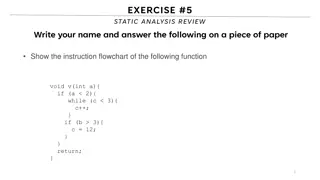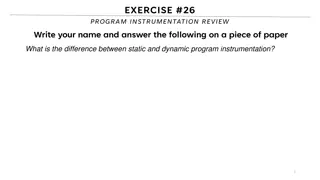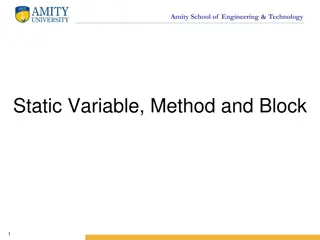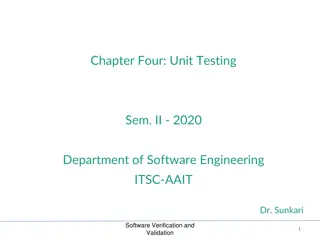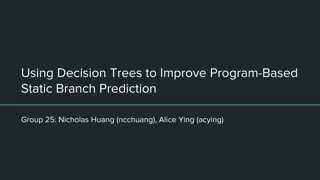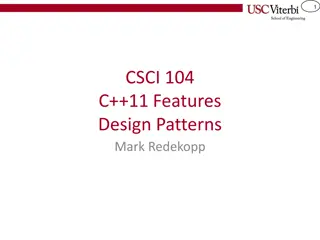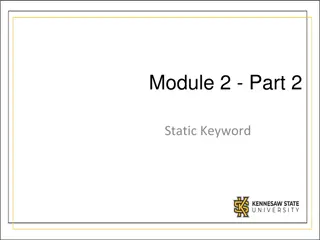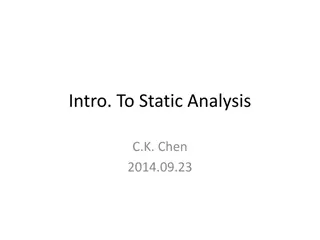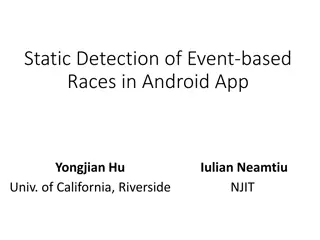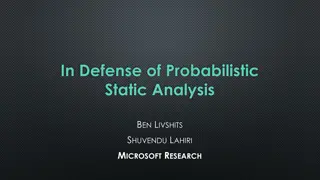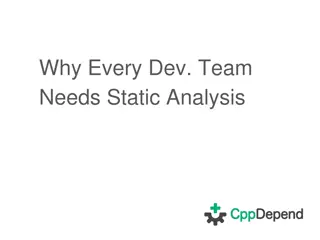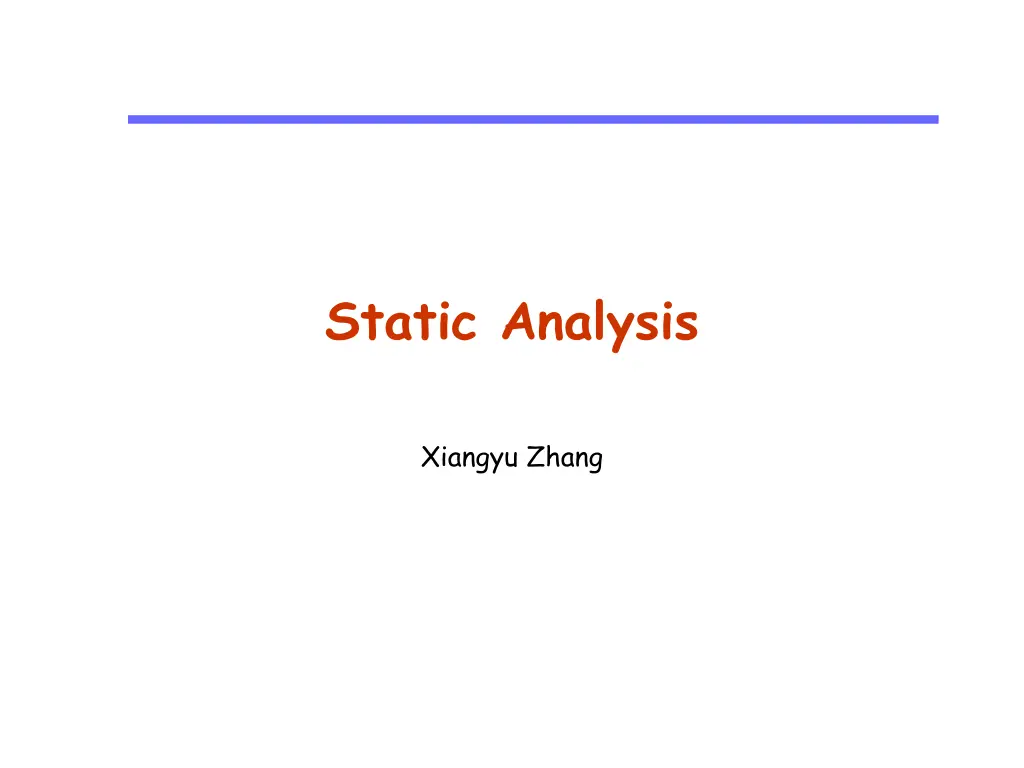
Static Analysis and Abstract Semantics in Software Engineering
Explore the complexity of static analysis and abstract semantics in software engineering, focusing on the challenges, benefits, and key concepts such as data flow analysis and data dependence computation. Discover why static analysis is vital for understanding program behavior and how abstract state models can enhance analysis processes in the CS510 software engineering domain.
Download Presentation

Please find below an Image/Link to download the presentation.
The content on the website is provided AS IS for your information and personal use only. It may not be sold, licensed, or shared on other websites without obtaining consent from the author. If you encounter any issues during the download, it is possible that the publisher has removed the file from their server.
You are allowed to download the files provided on this website for personal or commercial use, subject to the condition that they are used lawfully. All files are the property of their respective owners.
The content on the website is provided AS IS for your information and personal use only. It may not be sold, licensed, or shared on other websites without obtaining consent from the author.
E N D
Presentation Transcript
Static Analysis Xiangyu Zhang
Static Analysis Is Considered More Difficult Difficult to understand Data flow analysis framework Why it is designed in such a way? Is it a magic bullet? Guarantees: distributive versus non-distributive? CS510 S o f t w a r e E n g i n e e r i n g Many terms Context/flow/path/field-sensitivity Complex analysis Points-to Without our efforts on formalizing dynamic analysis, static analysis becomes much more apprehendable 2
Intuition Instead of concretely executing the program, let s statically execute/traverse it Instead of producing concrete execution states, let s have abstract state related to the analysis CS510 S o f t w a r e E n g i n e e r i n g 3
Analysis: Compute Data Dependence Statically Let s use the simplest language first CS510 S o f t w a r e E n g i n e e r i n g Program P ::= s Statement s ::= s1; s2 | x=L y | x =L y op z | x=L c | if (xL) s1 else s2 | while (xL) s Operation op :: = + | - | * | / | > | < | Value c :: = 0 | 1 | 2 | true | false Variable x, x1, x2, x3 4
Configuration < ?,?,? > < ? ,? ,? > Definition D: Variable -> Label Dependences X: P (Label Label) In contrast, dynamic dependence detection has the following configuration < ?,?,?,?,?,? > < ? ,? ,? ,? ,? ,? > Counter C: Label -> Int Definition D: Address -> Label Int Dependences X: P (Label Int Label Int) We call D and X in the first configuration the abstract domain, as they have nothing to do with execution Note that the store is not part of the static configuration CS510 S o f t w a r e E n g i n e e r i n g 5
Abstract Semantics ? = ?[? ?] Const-Assign < ? =??;?,?,? > < ?,? ,? > CS510 S o f t w a r e E n g i n e e r i n g ? = ? ? ? ? = ? < ?,? ? > < ? =??;?,?,? > < ?,? ,? > Copy ? = ? ? ? ? = ? < ?,? ? > < ?,? ? > < ? = ? + ?;?,?,? > < ?,? ,? > BinOp-Add 6
Abstract Semantics ??? If < ?? ? ?? ???? ??;?,?,? > ??? CS510 S o f t w a r e E n g i n e e r i n g There is no concrete store. We do not know the branch outcomes. What can we do with the conditional statements and loop statements? Idea: let s explore all possible branches If we have explored a branch with the same (abstract) state, we can skip the branch Use a worklist 7
Configuration < ?,?,?,?,? > < ? ,? ,? ,? ,? > Definition D: Variable -> Label Dependences X: P (Label Label) WorkList W: P (Definition Statement) Visited V: P (Definition Statement) CS510 S o f t w a r e E n g i n e e r i n g 8
Abstract Semantics ? = ?[? ?] Const-Assign < ?,?,? =??;?,?,? > < ?,?,?,? ,? > CS510 S o f t w a r e E n g i n e e r i n g ? = ? ? ? ? = ? < ?,? ? > < ?,?,? =??;?,?,? > < ?,?,?,? ,? > Copy ? = ? ? ? ? = ? < ?,? ? > < ?,? ? > < ?,?,? = ? + ?;?,?,? > < ?,?,?,? ,? > BinOp-Add 9
Abstract Semantics ? = ? < ?,??;? > < ?,??;? > ? < ?,??;? > ? ? = ? < ?,? ? > ? = ? < ?,??;? > < ?,??;? > < ?,?,?? ?? ?? ???? ??;?,?,? > < ? ,? ,??;?,?,? > If CS510 S o f t w a r e E n g i n e e r i n g While < ?,?,????? ? ??;?,?,? > < ?,?,?? ? ??;????? ? ?? ???? ????;?,?,? > ? =< ? ,? > ? Next-Path < ?,?,????,?,? > < ?,? ,?,? ,? > 10
An Example 1: sum=0 2: i=1 3: while ( i<N) do 4: 5: endwhile 6: print(sum) CS510 S o f t w a r e E n g i n e e r i n g i=i+1 sum=sum+i 11
Two Importance Properties Does the analysis terminate How does it handle loops? Is it sound? Does it computes what it claims to compute (through a declarative statement) CS510 S o f t w a r e E n g i n e e r i n g 12
Property One: Termination The abstraction domain is finite Visited V: P (Definition Statement) CS510 S o f t w a r e E n g i n e e r i n g By definition a partial order between the abstract values, called the lattice, and showing that the computed abstract values can only change strict- monotonically, we ensure termination Set subsumption 13
Property Two: Soundness Declarative statement. If there is a path from L1 to L2, L1 defines variable x and L2 uses x, and there is not another definition of x along the path, L1->L2 must be in the computed dependence set. How to prove? Our algorithm never enumerates all paths. Instead, it uses a work-list and may exercise a path from the middle CS510 S o f t w a r e E n g i n e e r i n g 14
Property Two: Soundness Proof Trace semantics < ?,?,?,?,?,? > < ? ,? ,? ,? ,? ,? > Definition D: Variable -> Label Dependences X: P (Label Label) WorkList W: P (Definition Trace Statement) Visited V: P (Definition Statement) Trace T: Label* CS510 S o f t w a r e E n g i n e e r i n g 15
Abstract Semantics ? = ?[? ?] < ?,?,? =??;?,?,?,? > < ?,?,?,? ?,? ,? > Const-Assign CS510 S o f t w a r e E n g i n e e r i n g ? = ? < ?,?,??;? > < ?,??;? > ? < ?,??;? > ? ? = ? < ?,? ? > ? = ? < ?,??;? > < ?,??;? > < ?,?,?? ?? ?? ???? ??;?,?,?,? > < ? ,? ,??;?,? ?,?,? > If 16
Property Two: Soundness Proof Lemma: If there is a path from L1 to L2, L1 defines variable x and L2 uses x, and there is not another definition of x along the path, the evaluation must generate a trace satisfying the condition (which may not be the specific path though) Lemma 1: There must be a trace leading to L1 Lemma 2: There must be a trace leading from L1 to L2 Proof by contradiction. If not, the new definition at L1 does not take the branch leading to L2 Lemma3: There must be a trace leading from L1 to L2 without any redefinition of x. Proof by contradiction. Assume all traces from L1 to L2 have redefinition. There must be a predicate preceding the redefinition leading to L2 Given such a trace, it must be D[x]=L1 at L2 Proof by contradiction CS510 S o f t w a r e E n g i n e e r i n g 17
Way to Improve Our Previous Algorithm It is too expensive to enumerate individual paths How about (abstractly) execute both branches of a predicate and aggregate the results before execute the continuation? CS510 S o f t w a r e E n g i n e e r i n g 18
Configuration < ?,?,?,?,? > < ? ,? ,? ,? ,? > Definition D: Variable -> P(Label) Dependences X: P (Label Label) WorkList W: P (Definition Statement) Visited V: P (Definition Statement) CS510 S o f t w a r e E n g i n e e r i n g 19
Abstract Semantics ? = ?[? {?}] < ? =??;?,?,? > < ?,? ,? > Const-Assign CS510 S o f t w a r e E n g i n e e r i n g ? = ? ? {?} Copy ? = ? {< ?,? > | ? ? ? } < ? =??;?,?,? > < ?,? ,? > ? = ? ? {?} ? = ? < ?,? > ? ? ? ? ? } < ? = ? + ?;?,?,? > < ?,? ,? > BinOp-Add 20
Abstract Semantics ?? = ? < ?,? > | ? ? ? < ??,?,?? > < ????,??,?? > < ??,?,?? > < ????,??,?? > ? = ?? ?? < ?? ?? ?? ???? ??;?,?,? > < ?,? ,? > CS510 S o f t w a r e E n g i n e e r i n g ? = ?? ?? If ?? = ? < ?,? > |? ? ? < ??,?,?? > < ????,??,?? > ?? ? ? = ? ?? < ????? ? ??;?,?,? > < ????? ? ??;?,? ,? > ? = ?? ?? While 21
Abstract Semantics CS510 S o f t w a r e E n g i n e e r i n g ?? = ? < ?,? > | ? ? ? < ??,?,?? > < ????,??,?? > ?? ? While-Exit < ????? ? ??;?,?,? > < ?,?,?? > 22
An Example 1: sum=0 2: i=1 3: while ( i<N) do 4: 5: endwhile 6: print(sum) CS510 S o f t w a r e E n g i n e e r i n g i=i+1 sum=sum+i 23
Termination and Soundness Termination can be proved by the monotonic increase of D at while statement(s) Soundness If there is a path from L1 to L2, L1 defines variable x and L2 uses x, and there is not another definition of x along the path, L1->L2 must be in the computed dependence set. Proof sketch: for each definition d in D, we associate it with a witness trace. For each step of eval, all the definitions have their witness traces incremented by the step. We define the provenance of d the set of witness traces of d starting from the definition to its deadth (redefinitions). Then prove by contradiction that there is not a witness trace covers both L1 and L2. Unfortunately, not all the analyses can be optimized by evaluating both branches and then their continuation CS510 S o f t w a r e E n g i n e e r i n g 24
Alias Analysis For each pointer variable, determine the set of global variables and the heap objects that may be pointed-to by the variable One of the most important analyses CS510 S o f t w a r e E n g i n e e r i n g 25
Heap Language Program P ::= s Statement s ::= s1; s2 | x=L y | x =L y op z | x=L c | x=L &y | (*x)=L y | x=L *y | x=L malloc(y) if (xL) s1 else s2 | while (xL) s Operation op :: = + | - | * | / | > | < | Value c :: = 0 | 1 | 2 | true | false Address a :: = 0 | 1 | 2 Variable x, x1, x2, x3 Label L, L1, L2, CS510 S o f t w a r e E n g i n e e r i n g 26
Configuration < ?,?,?,?,? > < ? ,? ,? ,? ,? > Alias A: P (Variable Label P(Variable|Label)) PointsTo T: (Variable | Label) -> P(Variable|Label) WorkList W: P (PointsTo Statement) Visited V: P (PointsTo Statement) CS510 S o f t w a r e E n g i n e e r i n g 1 x=malloc(10); 2 p=&y 3 (*x)=p 4 q=p+i 5 (*q)=x 27
Abstract Semantics Const-Assign < ?,?,? =??;?,?,? > < ?,?,?,?,? > CS510 S o f t w a r e E n g i n e e r i n g ? = ? ? ?[?] ?[?] ??? ? = ? {< ?,?,? ? >} < ?,?,? =??;?,?,? > < ?,?,?,? ,? > Copy ? = ? ? ?[?] ? = ? {< ?,?,? ? >} < ?,?,? = ? + ?;?,?,? > < ?,?,?,? ,? > ?[?] ??? BinOp-Add 28
Abstract Semantics ? ? ??? ?[?] ??? BinOp-Excp < ?,?,? = ? + ?;?,?,? > < ?,?,??????,?,? > CS510 S o f t w a r e E n g i n e e r i n g ? = ? ? ? ? = ? {< ?,?,? >} < ?,?,? =?&?;?,?,? > < ?,?,?,? ,? > Addr-of ? = ? ? ? ? = ? {< ?,?,? >} < ?,?,? =?&??????(?);?,?,? > < ?,?,?,? ,? > Malloc ? = ? ? ? ? ,? ?[?] ?[?] ? ? ? ????? ? ,? = ? {< ?,?,?[?] >} < ?,?,( ?) =??;?,?,? > < ?,?,?,? ,? > Strong update versus weak update Pnt-Write 29
Abstract Semantics CS510 S o f t w a r e E n g i n e e r i n g ? = ? ? ? ? ? ? ? } ? = ? {< ?,?, ? ? ? ? ? } >} < ?,?,? =?( ?);?,?,? > < ?,?,?,? ,? > Pnt-Read 30
Abstract Semantics ? = ? < ?,??;? > < ?,??;? > ? < ?,??;? > ? ? = ? < ?,??;? > < ?,??;? > < ?,?,?? ?? ?? ???? ??;?,?,? > < ? ,? ,??;?,?,? > If CS510 S o f t w a r e E n g i n e e r i n g While < ?,?,????? ? ??;?,?,? > < ?,?,?? ? ??;????? ? ?? ???? ????;?,?,? > ? =< ? ,? > ? Next-Path < ?,?,????,?,? > < ?,? ,?,? ,? > 31
Example 1: p=&x 2: q=malloc(10) 3: *q=p 4: t=q+2 5: *t=malloc(5) 6: r=(*t) 7 (*r)=&p CS510 S o f t w a r e E n g i n e e r i n g 32
A More Efficient Alias Analysis Traversing different paths is very expensive How about we ignore the control flow Eliminate strong update x = never overwrites the PointsTo set of x, but rather add to it CS510 S o f t w a r e E n g i n e e r i n g x=&y x=&z t=x PointsTo ->: (Variable | Label) X (Variable|Label) Eg. x -> y (read as x points to y) 33
Analysis Rules ? = &? ? ? ? =???????(?) ? ? CS510 S o f t w a r e E n g i n e e r i n g ? = ? ? ? ? ? ? = ? ? ? ? ? ? ? ? = ? ? ? ? ? ? ? ? = ? + ? ? ? ? ? 34
Example 1: p=malloc (10) 2: (*p)=&x 3: q=p+1 4: (*q)=&y 5: r=q+1 6: (*r)= &z 7: i=0; 8: t=p; 9: while (i<3) { 10: z=(*t); 11: t=t+2; 12: i=i+1; 13: } 14: x=(*z); CS510 S o f t w a r e E n g i n e e r i n g 35
Flow Sensitive and Flow Insensitive Analysis With and without respecting control flow The analyses we have learned, except the preceding alias analysis, are flow sensitive Other flow insensitive analysis Type inference CS510 S o f t w a r e E n g i n e e r i n g 36
Context Sensitive and Context Insensitive Analysis Program P ::= Global vd; fd; s VarDef vd ::= x | vd; x Function f :: = M(y) { s } FuncDef fd :: = f | fd; f FuncId M, M1, M2, Statement s ::= s1; s2 | x=L y | x =L y op z | x=L c | if (xL) s1 else s2 | while (xL) s | call(M, x) L CS510 S o f t w a r e E n g i n e e r i n g Operation op :: = + | - | * | / | > | < | Value c :: = 0 | 1 | 2 | true | false Variable x, x1, x2, x3 37
Semantics < ?,?,?,? > Context C: Label* Stack ?: Context X Var -> Value isGlobal (x): Var -> Bool CS510 S o f t w a r e E n g i n e e r i n g 38
Semantics Rules ? = ? < ?,? > ? < ? = ?;?,?,?,? > < ?,? ,?,? > ????????(?) Local-Const- Assign CS510 S o f t w a r e E n g i n e e r i n g ? = ? ? ? ?,? ????????(?) ????????(?) < ? = ?;?,?,?,? > < ?,? ,?,? > GL-Copy ? ? = ? ? ????????(?) ? = ?[< ? ,? > ?[?]] < ? ,?,? ,? > < ????,? ,? ,? > < ???? ?,??;?,?,?,? > < ?,? ,?,? > ? ? Call 39
Context Sensitivity in Alias Analysis A () { 1: B(&x, &y) 2: B(&z, &t) } B (p,q) { 10: (*p)=q } CS510 S o f t w a r e E n g i n e e r i n g 40
Alias Analysis Rules with Functions ? = &? ? ? ? =???????(?) ? ? CS510 S o f t w a r e E n g i n e e r i n g ? = ? ? ? ? ? ? = ? ? ? ? ? ? ? ? = ? ? ? ? ? ? ? ? = ? + ? ? ? ? ? ???? ?,? ? ? ? ? ? ? ? 41
Context Sensitive Alias Analysis The impression of context insensitive analysis comes from that information from different contexts is undesirable merged Context sensitive alias analysis CS510 S o f t w a r e E n g i n e e r i n g CPointsTo ->: Context X (Variable | Label) X (Variable|Label) Eg. ? ? ? (read as x points to y in context C) CStatement :Context X Statement Eg. ? ? (read there is statement s in context C) 42
Context Sensitive Alias Analysis ? ? = &? ? ? ? ? ? =???????(?) ? ? ? CS510 S o f t w a r e E n g i n e e r i n g ? ? = ? ? ? ? ? ? ? ? ? = ? ? ? ? ? ? ? ? ? ? ? ? = ? + ? ? ? ? ? ? ? ? ? = ? ? ? ? ? ? ? ? ? ? ? ???? ?,? ? ? = ? ? ? ? ? ? ? ? ? ? ? ? ? ? ? ? ? ????????(?) ? ? ? ? ?? ? ?? ???? ?? ? ?? ? ?? ? ??;?? ? ?? ? ?? 43
Example A () { 1. s=t 2: B( ) 3: C( ) } C () { 20: D(&x, &m ) 21: t=x } CS510 S o f t w a r e E n g i n e e r i n g B () { 10: D(&x, &y ) 11: t=x } D (p,q) { 30: (*p)=q } 44
Context Sensitivity in Flow Sensitive Static Dependence Analysis A () { 1: B( ) 2: C( ) } C () { 20: x= 21: D( ) 22: = x } CS510 S o f t w a r e E n g i n e e r i n g B () { 10: x= 11: D ( ) 12 .. = x } D ( ) { 30: y= } How would you design the rules? 45
Traditional Data Flow Analysis Framework For each block node n and every variable x ADin[x@n]=Adout[x@n] = change = true; while change do begin change = false; for any n and x ADin[x@n]= oldvalue = Adout[x@n] ; Adout[x@n] = F(ADin[x@n]) if Adout[x@n] != oldvalue then change = true; end end CS510 S o f t w a r e E n g i n e e r i n g [ @ ] AD x n p ' n s predecesso r n out p 46
Two important ingredients of data flow analysis Abstract domain The results we want to compute by static analysis CS510 S o f t w a r e E n g i n e e r i n g Transfer function How the abstract values are computed/updated at each relevant instruction Need to consider the instruction semantics 47
Reaching Definition Analysis Analyze multiple paths at a time and compute aggregate information directly. CS510 S o f t w a r e E n g i n e e r i n g Defin[x@n]: all the possible definitions of x along some path reaching n (before getting through n) Defin[x@n]= For any x!=y (node n is y= ) Defout[x@n]=Defin[x@n] Defout[y@n]={n} [ @ ] Def x n p ' n s predecesso r n out p 48
Example for Computing Dependences 1 2 3 4 5 6 7 8 9 10 Output(z); Input (x,y); if (x<0) p=-y; else p=y; z=1 while (p!=0) z=z*x p=p-1; CS510 S o f t w a r e E n g i n e e r i n g 49
Again, two important properties Termination Semi-lattice Soundness Precision loss by non-distributivity CS510 S o f t w a r e E n g i n e e r i n g 50 2025 5 10


